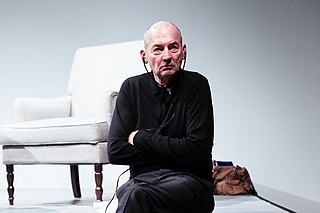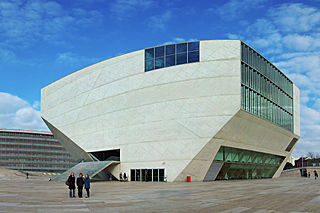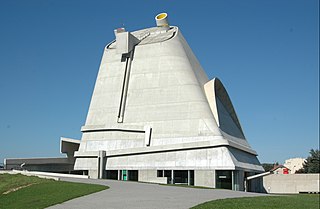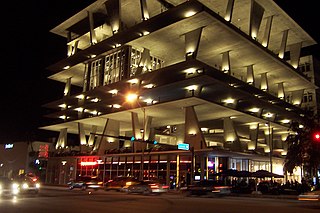Related Research Articles

Remment Lucas Koolhaas is a Dutch architect, architectural theorist, urbanist and Professor in Practice of Architecture and Urban Design at the Graduate School of Design at Harvard University. He is often cited as a representative of Deconstructivism and is the author of Delirious New York: A Retroactive Manifesto for Manhattan.

The Guggenheim Museum Bilbao is a museum of modern and contemporary art in Bilbao (Biscay), Spain. It is one of several museums affiliated to the Solomon R. Guggenheim Foundation and features permanent and visiting exhibits of works by Spanish and international artists. It was inaugurated on 18 October 1997 by King Juan Carlos I of Spain, with an exhibition of 250 contemporary works of art. It is one of the largest museums in Spain.

Herzog & de Meuron Basel Ltd. is a Swiss architecture firm headquartered in Basel (Switzerland), founded by Jacques Herzog and Pierre de Meuron.
The year 2003 in architecture involved some significant architectural events and new buildings.
The year 2004 in architecture involved some significant architectural events and new buildings.
The year 2001 in architecture involved some significant architectural events and new buildings.
The year 2000 in architecture involved some significant architectural events and new buildings.
The year 1992 in architecture involved some significant architectural events and new buildings.
The year 2007 in architecture involved some significant architectural events and new buildings.

The Serpentine Galleries are two contemporary art galleries in Kensington Gardens, Westminster, Greater London. Recently rebranded to just Serpentine, the organisation is split across Serpentine South, previously known as the Serpentine Gallery, and Serpentine North, previously known as the Sackler Gallery. The gallery spaces are within five minutes' walk of each other, linked by the bridge over the Serpentine Lake from which the galleries get their names. Their exhibitions, architecture, education and public programmes attract up to 1.2 million visitors a year. Admission to both galleries is free. The CEO is Bettina Korek, and the artistic director Hans Ulrich Obrist.
The year 2005 in architecture involved some significant architectural events and new buildings.

Blobitecture, blobism and blobismus are terms for a movement in architecture in which buildings have an organic, amoeba-shaped building form. Though the term blob architecture was already in vogue in the mid-1990s, the word blobitecture first appeared in print in 2002, in William Safire's "On Language" column in the New York Times Magazine. Though intended in the Safire article to have a derogatory meaning, the word stuck and is often used to describe buildings with curved and rounded shapes.

The Casa da Música is a concert hall in Porto, Portugal. It was designed by architect Rem Koolhaas and opened in 2005.
Starchitect is a portmanteau used to describe architects whose celebrity and critical acclaim have transformed them into idols of the architecture world and may even have given them some degree of fame among the general public. Celebrity status is generally associated with avant-gardist novelty. Developers around the world have proven eager to sign up "top talent" (i.e., starchitects) in hopes of convincing reluctant municipalities to approve large developments, of obtaining financing or of increasing the value of their buildings. A key characteristic is that the starchitecture is almost always "iconic" and highly visible within the site or context. As the status is dependent on current visibility in the media, fading media status implies that architects lose "starchitect" status—hence a list can be drawn up of former "starchitects".

Contemporary architecture is the architecture of the 21st century. No single style is dominant. Contemporary architects work in several different styles, from postmodernism, high-tech architecture and new references and interpretations of traditional architecture to highly conceptual forms and designs, resembling sculpture on an enormous scale. Some of these styles and approaches make use of very advanced technology and modern building materials, such as tube structures which allow construction of buildings that are taller, lighter and stronger than those in the 20th century, while others prioritize the use of natural and ecological materials like stone, wood and lime. One technology that is common to all forms of contemporary architecture is the use of new techniques of computer-aided design, which allow buildings to be designed and modeled on computers in three dimensions, and constructed with more precision and speed.
The Prix d'architecture de l'Équerre d'argent is a French architecture award. This prize was launched in 1960 by "Architecture Française" magazine and its director Michel Bourdeau.

Saint-Pierre is a concrete building in the commune of Firminy, France. The last major work of Le Corbusier, it was started in 1973 and completed in 2006, forty-one years after his death.
The year 2008 in architecture involved some significant architectural events and new buildings.

1111 Lincoln Road is a parking garage in the South Beach section of Miami Beach, Florida, designed by the internationally known Swiss architectural firm of Herzog & de Meuron. It is located at the western end of the Lincoln Road Mall at the intersection with Alton Road, and can house some 300 cars. Since its opening in 2010, it has attracted considerable interest because its unique appearance is different from more traditional parking garage designs.
Louise Lemoine is a French video artist and filmmaker. She is an associate of the film production and publishing company Bêka & Partners.
References
- 1 2 "Vanity Fair's World Architecture Survey: the Complete Results". Vanity Fair . 30 June 2010. Archived from the original on November 8, 2014. Retrieved 22 July 2010.
- ↑ Architecture’s Modern Marvels
- ↑ Tyrnauer, Matt (30 June 2010). "Architecture in the Age of Gehry". Vanity Fair . Retrieved 22 July 2010.
- 1 2 "Architecture's Modern Marvels". Vanity Fair . June 30, 2010. Retrieved 22 July 2010.
- ↑ Kamin, Blair (July 21, 2010). "The blind spot in Vanity Fair's world architecture survey: green design". Chicago Tribune . Retrieved 22 July 2010.
- ↑ Hosey, Lance (July 27, 2010). "The G List". Architect. Retrieved 28 July 2010.
- ↑ Ng, David (June 30, 2010). "Frank Gehry's Bilbao museum tops Vanity Fair architecture list". Culture Monster . Los Angeles Times . Retrieved 22 July 2010.
- ↑ Winston, Anna (5 July 2010). "Vanity Fair reveals vanity voting behind list of best modern buildings". Building Design . Retrieved 22 July 2010.
- ↑ Glick Kudler, Adrian (June 30, 2010). "Bilbao Wins, But Which Architects Nominated Themselves to Vanity Fair List?". Curbed . Retrieved 22 July 2010.